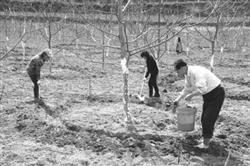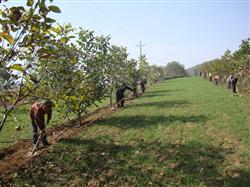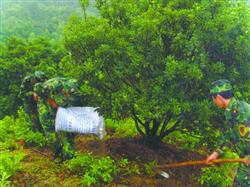How to manage walnut trees in autumn and winter?

How to manage walnut trees in autumn and winter? Please guide the management of walnut trees in autumn and winter, including soil, fertilizer, water management, pruning and anti-freezing. For detailed operation, please refer to the following methods: soil, fertilizer and water management of walnut trees in autumn and winter: unfruited trees turn deep into the soil and build tree plates after defoliation and before soil freezing, usually at a depth of 20cm and 25cm. The base fertilizer is mainly rotten organic fertilizer, the amount of fertilizer is 2550 kg per plant, and 2kg superphosphate can also be added. When fertilizing, the annular ditch method can be used, that is, an annular ditch with a width of 20 cm 40 cm and a depth of 30 cm is dug around the crown, and the topsoil and core soil are placed separately. After digging, the fertilizer is filled, and then mixed with the topsoil, and finally filled with an appropriate amount of core soil flat with the original ground. After the leaves of the first fruit trees fall, turn the soil deeply before the soil is frozen, and build the same young trees as the tree plates. 30-50 kg of mature organic fertilizer was applied to each plant as base fertilizer and 2-5 kg of superphosphate was added. When fertilizing, the strip ditch method can be used to dig parallel fertilizer ditches between rows or trees of walnut trees along the opposite sides of the crown edge. The ditch is about 20cm wide and 30cm deep, and the length is determined according to the size of the crown. After mixing the fertilizer and topsoil, finally fill it with the heart soil to level with the original ground. Note that the position of digging trenches should be changed once a year. The management method of trees after defoliation and before soil freezing in full fruit stage is the same as that of young trees. The base fertilizer was mainly organic fertilizer, 50-80 kg per plant, and 2-5 kg superphosphate at the same time. The radiation ditch fertilization method can be used when fertilizing. 3 to 6 trenches with a width of 20 cm 40 cm and a depth of 30 cm are dug from the tree trunk at a certain distance from the inside to the outside, and gradually deepened from the inside to the outside. After digging, the fertilizer and topsoil are mixed and filled, and finally the core soil is filled to the level with the original ground. Pay attention to changing the location of the ditch every year. Water should be watered after fertilization to facilitate the absorption of fertilizer. Pruning and rejuvenation of walnut trees in autumn and winter: young tree pruning is mainly to cultivate a good skeleton, lay a good foundation, rapidly expand the crown, promote early fruit and early high yield. The commonly used tree shape is the small crown sparse layer shape, the central trunk of this tree shape is obvious, the fixed trunk is 80 cm, and the main branches are 6-8, which are scattered on the central trunk in 3 layers, the distance between the first and second layers is 80 cm, and the distance between the second and third layers is 70 cm. There are 2 lateral branches in each of the first and second layers, and 1 or 2 lateral branches in the third layer. The pruned walnut trees entered the initial fruit stage 2-3 years or 5-6 years after planting. The main task of pruning in this period is to continue to cultivate the main and lateral branches according to the requirements of the tree, so that the skeleton is firm, the growth is balanced, and the fruiting branches are equipped in a planned way. Walnut trees in this period should strictly control the back branches and leave as many auxiliary branches as possible to supplement the space and increase the early yield. For the pruning of auxiliary branches, it is necessary to remove the strong and retain the weak, or put it first and then shrink, and then combine it with expansion and contraction to make it more fruitful. The pruning of trees in full fruit stage mainly regulates the relationship between vegetative growth and reproductive growth, and improves the ventilation and light transmission conditions of trees. The pruning methods of "first releasing and then shrinking" and "removing the upper branch and leaving the oblique branch" can be used in the branch culture group, and the overgrown branches in this period can be properly cultivated into the fruiting branch group to prolong the full fruit period. In this period of pruning, special attention should be paid to prevent the result part from moving outward, causing the inner chamber to be bald, so when the main branch does not need to extend, the head can be changed repeatedly to prevent outward expansion. Results the branch group should combine the large, medium and small configuration and distribute evenly, so that the large fruiting branch group is distributed on the inside, the small one is on the outside, the tree is more under the tree and less on the tree, and the crown is not dense on the outside and not empty on the inside. The continuous fruiting force of the medium-long fruiting branch group is strong and should not be truncated. Regeneration and rejuvenation of walnut trees in this period, the branchlets of walnut trees dried up seriously, the growth of outer branches obviously weakened and sagged, the crown shrank, there were a large number of "scorched shoots", and the yield decreased significantly, even no harvest. This period should be renewed and rejuvenated in time. When renewing and rejuvenating, you can choose the strong main branch, keep 50 cm to 100 cm, saw off the rest, after the branch, select 2 or 3 strong branches with suitable position on each main branch to cultivate the first-class lateral branches. The branch group can also be renewed, and the weak large and medium-sized fruiting branches can be retracted to the strong branches to promote the development of new branches; the small branch groups can be weak and strong, and the new strong branches and long branches in the crown can be preserved and cultivated into all kinds of branch groups as far as possible. The lateral branches can also be renewed. On each main branch to be retained, 2-3 suitable lateral branches are selected, and the front or upper part of the strong branches are cut under each lateral branch. Walnut trees are cold-proof in autumn and winter: due to the large core of walnut branches, high water content and poor cold resistance, walnut trees are easy to suffer frost damage in cold and arid areas in the north, resulting in branches drying up. Therefore, in order to ensure the normal growth of young trees and prevent the occurrence of freezing injury, cold prevention measures should be taken after 1 ~ 2-year-old walnut trees have fallen leaves (usually from mid-November to early December). The most commonly used and effective method is to bury the soil to protect against the cold, that is, the whole tree is bent to the opposite side of the grafting joint, covering the soil 30 cm, and removing the covered soil before germination after the soil is thawed in the coming year. Some cold-resistant varieties may still have frost injury when the tree potential is large, so it is no longer suitable to bury the soil to prevent cold, so we can use the method of applying polyvinyl alcohol on side branches or new branches. Generally, polyvinyl alcohol (PVA) and water are boiled in a ratio of 15 to 20, first boil the water to about 50 ℃, then add PVA (cannot wait for the water to boil and then add, otherwise PVA cannot be completely dissolved, the solution is uneven), stir with the addition until it boils, then boil it with a gentle fire for 30 minutes. Use when the temperature drops to the point where the hand is not hot. In addition, you can also wrap the branches with 10 cm wide plastic cloth in early winter, or build a ridge to prevent cold before the soil is frozen. Click to get more hickory planting techniques click to get more fruit planting techniques
- Prev

How to manage walnut trees in autumn?
How to manage walnut trees in autumn? What do walnut trees need to pay attention to in autumn? Please introduce the fruit period of walnut trees in autumn. Due to the need of fruit, walnut trees consume a lot of nutrients. Fruit trees are characterized by weakness, obvious increase in diseases and insect pests, and even the structure of trees has changed.
- Next

How to make the red bayberry tree high yield next year?
How to make the red bayberry tree high yield next year? Is there any way to prevent red bayberry trees from growing old? Please introduce the method To make bayberry tree high yield and avoid big and small years in the coming year, you can refer to the following methods for management: After harvesting bayberry, while doing a good job in pest control, it is necessary to timely increase the application of organic fertilizer, supplement micro-fertilizer, balance the...
Related
- Moge, come on! The staff of the peasant association in the producing area of cantaloupe were frightened when the crowd gathered.
- Causes and Solutions of low Fruit setting rate of Apple
- Symptoms and control measures of passion fruit virus disease
- Fruit growing lesson: how do apple orchards keep high yields?
- Can you build orchards in the mountains? What are the pros and cons?
- How to manage the coloring period of Crisson grape?
- This paper introduces the processing technology of two kinds of fig products.
- How much is a month for retired teachers in rural areas by 2020?
- How can strawberry planting increase sugar content? We should pay attention to management in many aspects.
- What are the cultivation techniques on how to improve the yield of golden fruit?

